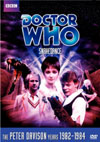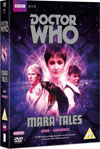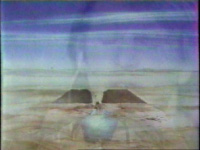DVD Extras include:
However, my opinion was not always so favourable, particularly when I first saw it. Writer Christopher Bailey continues the anti-tech writing style he began in this story's prequel "Kinda" (story no. 119), which denied my young thirst for laser beams, materializations, physical action, and most of the "magical" effects surrounding new sci-fi processes that fueled my early interest in the genre. Bailey has other aims in mind, and chiefly sustains the first three episodes with explorations of culture, character, and a form of long-forgotten crystal technology which few still believe in - all of which supports what I now believe to be the most important aspects of good science fiction. The final episode then layers in spiritual elements critical to a superb dramatic climax that satisfies on multiple levels, and has the added power of being able to positively affect viewers' lives, becoming one of the tours-de-force for Peter Davison's era.
Nyssa is seen trying out the first completely new everyday costume she's had since she joined the show, and Sarah Sutton and Peter Davison devise a few enjoyable additions to their first scenes surrounding this, thankfully keeping it tasteful and minimal enough not to interrupt the flow of the story. The new costume is welcome variety on the show, but sadly isn't any improvement on Nyssa's season 19 look. Thankfully, it only features for one story, until yet more variety wanders out of the TARDIS's wardrobe room.... Once more for season 20, Nyssa gets to play the chief companion to the Doctor as she did in "Arc of Infinity" (story no. 124). Although continuing to do an excellent job of it, there is less for her to do in this story, and less dramatic meat for her to get her teeth into. Her confrontation with Tanha in episode three has her being far too uncharacteristically silent. It is Janet Fielding who has far more acting to do, although only a relatively small percentage of it is as her regular character Tegan. A few nice new character bits come out for Tegan, such as the glimpse of what she was like when she was six years old, but for most of this story Fielding is playing the Mara instead, and not having a heck of a lot of solid things to do while hiding in the shadows. The Mara is largely a master of mysterious and successfully frightening parlour tricks in this tale - its true villainy occurs in the imagination as onlookers try to figure out what on Manussa it is doing and why, and of course in the backstory that is slowly pieced together as the adventure unfolds.
"Look at me!"A close study of this story reveals the thematic idea of fearful spectacle being the Mara's chief mechanism for gaining control over its intended subjects. This is in fact a reflection of how people are often steered off of a path of spiritual enlightenment, when constant distraction is offered to them instead, and fear-based ones often yield the most immediate results for little effort, assuming of course that one's subjects are weak-minded enough to play along. Just notice how often the Tegan-Mara's dialogue is about begging someone to look at something, and how pathetic it becomes when such attention is finally refused.Now the cliffhangers for this story come under a significant amount of flak by cast and crew on the DVD extras. Yes, they turn out to be far more insubstantial than cliffhangers of most other stories on the surface, largely because the reprises diffuse all tension so easily and quickly. But when you take a moment to notice how well this style of cliffhanger dovetails so neatly into the theme of fearful spectacle being the Mara's main mechanism for attaining power, the cliffhangers actually work well. As Richard Hurndall's Doctor says in the upcoming "The Five Doctors" (story no. 130), "Fear itself is largely an illusion" and each reprise shatters the illusion of its preceding cliffhanger so absolutely that one easily feels there was nothing really to be afraid of in the first place. A nice reflection of real life, although understandably this may disappoint the horror fans.
Which brings us to another point. It's easy to see how the production team of the new millennium might try to set a story such as this in colonial India a few centuries ago, as the parallels are great. But it achieves more in the sci-fi genre by being a clash between two completely alien cultures with the freedom to be anything, become anything, and have any kind of history that suits the adventure at hand. Sweet. Just what I look for these days, and precisely what is in far too short supply in the 2005-2007 years of the show. While there is every reason to believe that "Snakedance" features the same interplanetary Federation as was seen exploring the planet Deva Loka in "Kinda", there really is nothing in either story to indicate that this Federation is Earth-based, as many fans seem to have assumed. In my mind, it's alien, as it should be, and if we ever see any more of it on Doctor Who, it may yet surprise us with even stranger cultural twists. One of the things that makes these characters work so well is the way they are all so easily understandable - the idle prince, the socially climbing queen, the greedy showman, even the street vendor pushing trinkets. They're all real at first sight, unlike many of the more experimental characterizations one will encounter during the Sylvester McCoy era. The one bit that doesn't really work for me is the puppet play in the market - which of course doesn't really need to be anything too real in the first place. The plot of "Snakedance" is fairly well-constructed, and a bit better than "Kinda". Each episode works well both when viewed on its own, and in quick succession as a whole story. Episode Two successfully has the Doctor piecing together the mystery of the Mara with his characteristic exuberance, while the Mara externalizes itself and takes charge of its preliminary forces. Episode three is the mandatory captivity episode for this story, but even from within a jail cell, the Doctor's investigations are barely hindered, this time focusing more on how the Mara might best be resisted. Episode three remains strong and satisfies in many ways, but perhaps could have been better had more traditional Doctor Who action been used at this point. When action finally does begin at the very end of the episode, it leaves a feeling of being too little too late while the credits roll. Or fly, as the case may be.
Stillpoint QuestThe final episode incorporates a whole new level into the story. Up to this point, Peter Davison's Doctor has been excellent, yet a bit more frantic and frenzied than would be ideal, and employing tactics too argumentative to be as ideal or effective as one could hope for. Can you blame Ambril for locking up the raving nut he appears as when he interrupts the formal dinner at the end of part two? (His first exchange in Ambril's office, however, is exquisite.)But now, his role in this tale is really defined. The Doctor often serves as a story's hero, while his age and wisdom also makes him a mentor to traveling companions and local guest characters who have their own critical part to play. But here he is revealed to be the inexperienced junior in the technique that will overcome the Mara, an idea which his earlier faulty methods support, and now that he is ready, his mentor Dojjen appears. Classic mythological story-telling structure takes hold more than usual here, and lifts this adventure up another notch. The Doctor actually finds himself on a skill-&-wisdom learning curve for once, and makes rare progress on his centuries-long character arc. Sweet. What's up with the snake-bite though? Does it make any sense? Is it really necessary? Good questions. I actually think it's NOT necessary, but it demonstrates something which is elaborated on in full detail in our article: "Recipe for Health". Uniquely, this mentor brings forth some actual solid emotional and metaphysical information, expressed simply and helpfully. As such, it has the potential to reach beyond the Doctor and this story, to reach into viewers' lives consciously or unconsciously and have impact. Even after dismissing this story in my youth, I found Dojjen's lines coming back to me whenever I needed them most....
"Ask your question." "Steady your mind." "Attach to nothing." "Let go of your fear." "The Stillpoint is within yourself, nowhere else." "Here and Now. The dance goes on. It is all the dance. Everywhere and always." "So... Find the Stillpoint." And along with his words and his voice, came returning images from the program, of glowing blue crystals, of communion between mentor and hero, of faces filled with calm, assertive, all-knowingness, and of Peter Howell's brilliant new-age musical effects. Likely without realizing it, Doctor Who audiences were given a working formula for meditation. How many have yet tapped into its power to heal, to focus, to overcome fears, to become more brilliant?
Though I heartily rank this sequel much higher than its predecessor "Kinda" (story no. 119), I will acknowledge that, at least for the first three episodes, the excellence of "Snakedance" is centered primarily in its dialogue and performances, while "Kinda" is perhaps a bit more interesting visually, and horror-fans may easily find "Kinda" a bit closer to what they're looking for. "Snakedance" dominates in terms of spiritual/philosophical wisdoms, however, and has a much better and more focused concluding episode. Although it certainly helps to have seen "Kinda" before tackling "Snakedance", I don't really believe it necessary. You can still start with "Snakedance", and if intrigued to know more history and backstory, check out "Kinda" at a later point.
International Titles:Deutsch: (Das grosse Geistige Auge)Magyar: "Kígyótánc"Français: (Danse du serpent)Русский: "Танец змеи"This German translation names the story "The Great Mind's Eye", which perhaps better evokes the positive side of its main subject matter.
This story is available on DVD and VHS video. Click on the Amazon symbol for the location nearest you for pricing and availability:
Comments on this article are welcome. You may contact the author from this page:
the novel "Buddha: A Story of Enlightenment", by Dr. Deepak Chopra.
|










